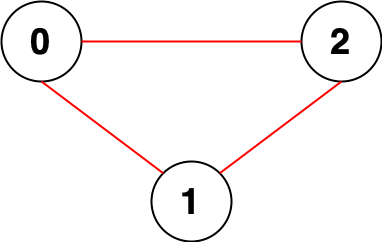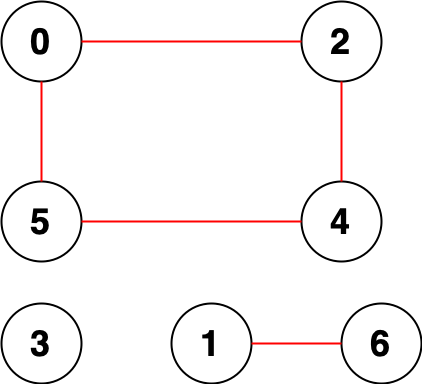2316.Count Unreachable Pairs of Nodes in an Undirected Graph
===
###### tags: `Medium`,`DFS`,`BFS`,`Graph`
[2316. Count Unreachable Pairs of Nodes in an Undirected Graph](https://leetcode.com/problems/count-unreachable-pairs-of-nodes-in-an-undirected-graph/)
### 題目描述
You are given an integer `n`. There is an **undirected** graph with `n` nodes, numbered from `0` to `n - 1`. You are given a 2D integer array edges where `edges[i]` = [$a_i$, $b_i$] denotes that there exists an **undirected** edge connecting nodes $a_i$ and $b_i$.
Return *the **number of pairs** of different nodes that are **unreachable** from each other*.
### 範例
**Example 1:**

```
Input: n = 3, edges = [[0,1],[0,2],[1,2]]
Output: 0
Explanation: There are no pairs of nodes that are unreachable from each other. Therefore, we return 0.
```
**Example 2:**

```
Input: n = 7, edges = [[0,2],[0,5],[2,4],[1,6],[5,4]]
Output: 14
Explanation: There are 14 pairs of nodes that are unreachable from each other:
[[0,1],[0,3],[0,6],[1,2],[1,3],[1,4],[1,5],[2,3],[2,6],[3,4],[3,5],[3,6],[4,6],[5,6]].
Therefore, we return 14.
```
**Constraints**:
* 1 <= `n` <= 10^5^
* 0 <= `edges.length` <= 2 * 10^5^
* `edges[i].length` == 2
* 0 <= $a_i$, $b_i$ < `n`
* $a_i$ != $b_i$
* There are no repeated edges.
### 解答
#### Python
```python=
class Solution:
def countPairs(self, n: int, edges: List[List[int]]) -> int:
graph = defaultdict(list)
for a, b in edges:
graph[a].append(b)
graph[b].append(a)
visits = set()
def dfs(node):
visits.add(node)
count = 1
for child in graph[node]:
if child in visits: continue
count += dfs(child)
return count
ans = 0
for i in range(n):
if i in visits: continue
c = dfs(i)
ans += c * (n - c)
return ans // 2
```
> [name=Yen-Chi Chen][time=Sat, Mar 25, 2023]
```python=
class Solution:
def countPairs(self, n: int, edges: List[List[int]]) -> int:
ans = n * (n - 1) // 2
graph = defaultdict(list)
for u, v in edges:
graph[u].append(v)
graph[v].append(u)
visited = set()
def dfs(node):
if node in visited:
return 0
visited.add(node)
cnt = 1
for nei in graph[node]:
cnt += dfs(nei)
return cnt
components = []
for node in range(n):
if node not in visited:
components.append(dfs(node))
for k in components:
ans -= k * (k - 1) // 2
return ans
```
>[name=Ron Chen][time=Sat, Mar 25, 2023]
#### Javascript
```javascript=
function countPairs(n, edges) {
const graph = new Array(n).fill(0).map(() => []);
for (const [v1, v2] of edges) {
graph[v1].push(v2);
graph[v2].push(v1);
}
const visited = new Array(n).fill(false);
// 找出所有連通圖,並計算每個連通圖的節點數
const graphNodes = [];
for (let i = 0; i < n; i++) {
if (visited[i]) continue;
let count = 0;
const stack = [i];
while (stack.length) {
const node = stack.pop();
if (visited[node]) continue;
visited[node] = true;
count++;
for (const v of graph[node]) {
stack.push(v);
}
}
graphNodes.push(count);
}
// 計算所有連通圖的組合數
let ans = 0;
for (let i = 0; i < graphNodes.length; i++) {
for (let j = i + 1; j < graphNodes.length; j++) {
ans += graphNodes[i] * graphNodes[j];
}
}
return ans;
}
```
> [name=Marsgoat][time=Mar 26, 2023]
### Reference
[回到題目列表](https://hackmd.io/@Marsgoat/leetcode_every_day)